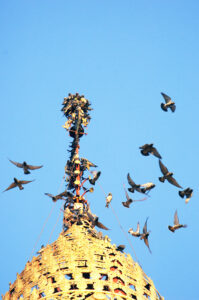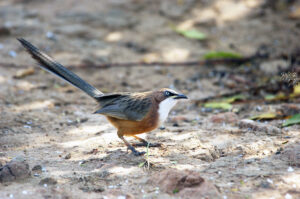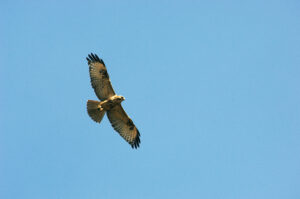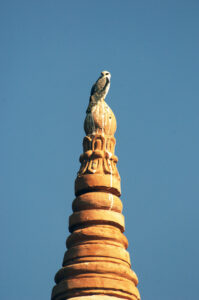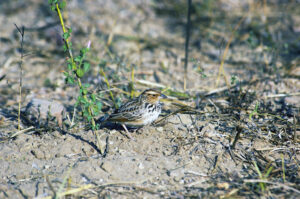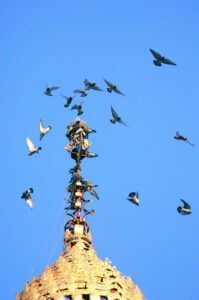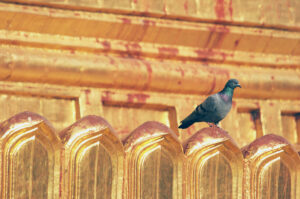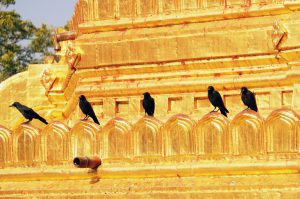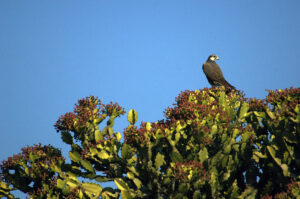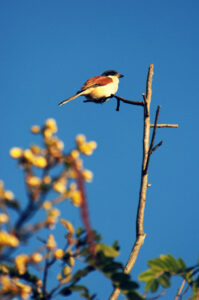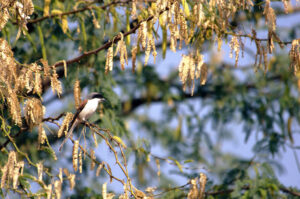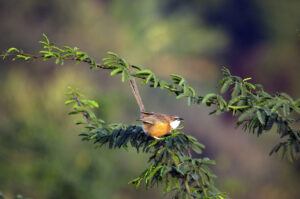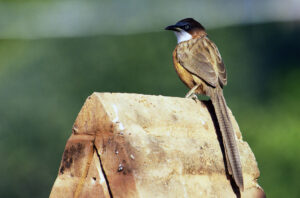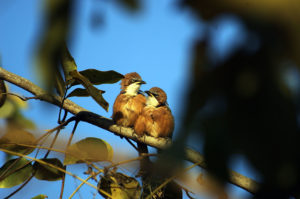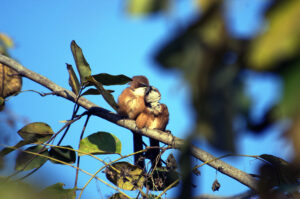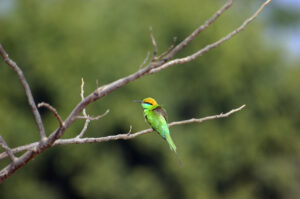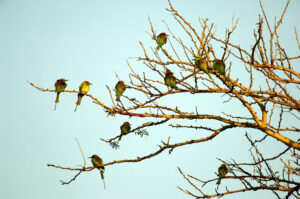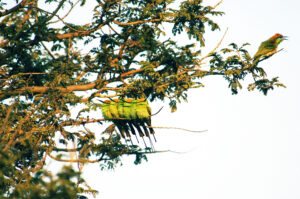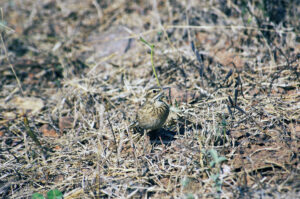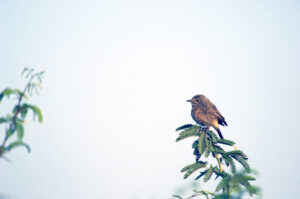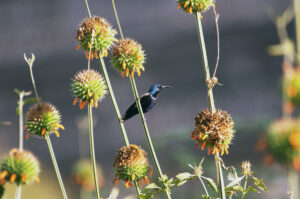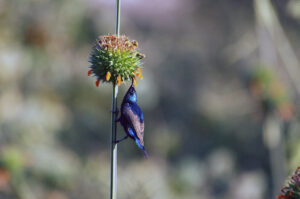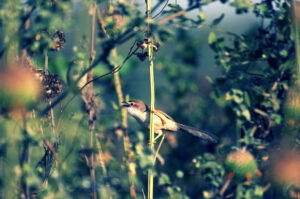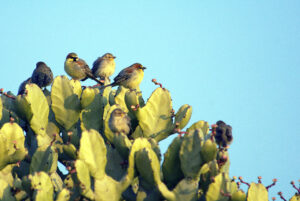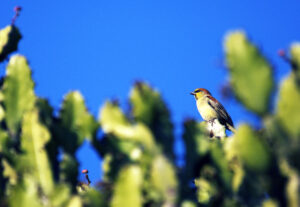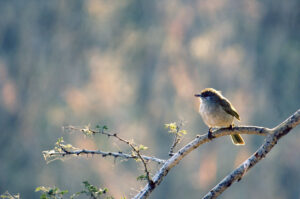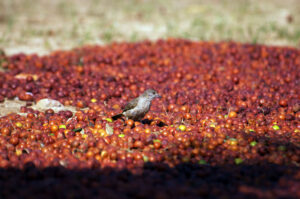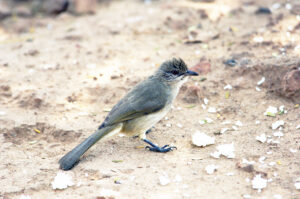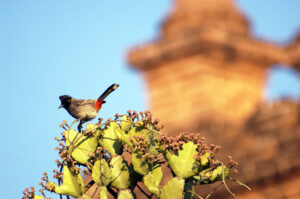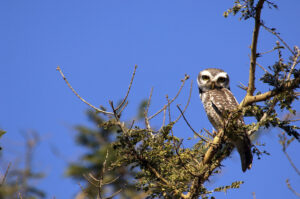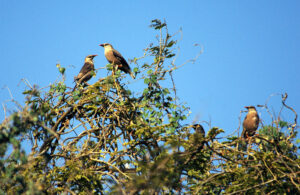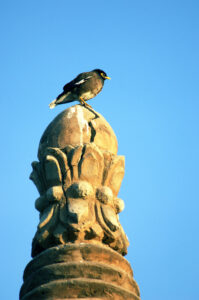Birds in Bagan
Ashy woodswallows (Artamus fuscus), gathered on their night roost on the spire of a pagoda. (Photo copyright © by Kaj Halberg)
White-throated babbler (Argya gularis) is common in Bagan. (Photo copyright © by Kaj Halberg)
Male purple sunbird (Cinnyris asiaticus), feeding in flowers of a species of lion’s ear, Leonotis nepetifolia. (Photo copyright © by Kaj Halberg)
A huge area around the town of Bagan, central Myanmar, is dotted with the remains of c. 2,200 Theravada Buddhist pagodas and temples, of which the major part lie in ruins. During the height of the Bagan Kingdom, between the 11th and 13th Centuries, more than 10,000 temples, pagodas, and monasteries were built in this area.
Bagan is situated on the shore of a branch of the largest river in Myanmar, the mighty Ayeyarwadi, in the British colonial time known as Irrawaddy. The habitat in this area is dry shrubland, dominated by acacias and a cactus-like species of tree spurge, Euphorbia antiquorum.
During a visit to Bagan in 2007, Judy and I stayed in a charming hotel in the centre of the shrubland, and we found the area so pleasant that we stayed here for more than two weeks. We spent the time walking around in the shrubland, occasionally resting at the shore of the Ayeyarwadi, or in the shade, provided by the many pagodas. During our stay, I succeeded in taking pictures of a large part of the local bird species.
Families, genera, and species are presented in alphabetical order. Nomenclature largely follows the IOC World Bird List (worldbirdnames.org). Information about etymology is often based on J.A. Jobling, 2010. The Helm Dictionary of Scientific Bird Names, Christopher Helm, London.
In case you encounter any errors on this page, I would be grateful to hear about it. You can use the address at the bottom of the page.
Accipitridae Hawks, eagles, and allies
A huge family, comprising about 66 genera and c. 250 species of small to large raptors, distributed worldwide, with the exception of Antarctica.
The family name is derived from the Latin accipiter (‘hawk’), from accipere (‘to grasp’), naturally alluding to the sharp talons.
Buteo Buzzards
A genus of about 28 species, distributed on all continents, except Australia and Antarctica. In the Old World, these birds are known as buzzards, whereas the word hawk is often used in North America. The generic name is the classical Latin name of the common buzzard (below).
Buteo buteo Common buzzard
This species, in its broadest sense, is distributed from western Europe eastwards to Kamchatka and Japan. However, some authorities regard eastern populations as two separate species, the eastern buzzard (B. japonicus) and the Himalayan buzzard (B. refectus).
Common buzzard, subspecies japonicus or refectus, soaring over Bagan. (Photo copyright © by Kaj Halberg)
Elanus Small kites
Members of this genus, comprising 4 quite similar species of small white, grey, and black raptors, are distributed throughout the globe, except in Antarctica. The generic name is a Latinized form of the Ancient Greek elanos (‘kite’).
Elanus caeruleus Black-winged kite
This bird has a very wide distribution, found in all of sub-Saharan Africa, in north-western Africa, the Iberian Peninsula, France, the Nile Valley of Egypt, at several locations throughout the Middle East, from the entire Indian Subcontinent eastwards to southern China and Taiwan, and thence southwards through Indochina and the Philippines to Indonesia and New Guinea.
The specific name is derived from the Latin caelum (‘sky’), and a diminutive suffix, thus ‘small sky’, i.e. having the colour of the sky, thus ‘sky-blue’, alluding to the bluish sheen in the plumage.
Black-winged kites, scanning the surroundings from pagoda spires. (Photos copyright © by Kaj Halberg)
Aegithinidae Ioras
A small family with only a single genus, Aegithina, comprising 4 species, found in the Indian Subcontinent and Southeast Asia. Formerly, they were placed with leafbirds and fairy-bluebirds in the family Irenidae.
The generic name is derived from Ancient Greek aigithos, a mythical bird mentioned by Greek scientist and philosopher Aristotle (384-322 B.C.) and other classical authors.
Aegithina tiphia Common iora
This species is distributed in warmer areas of the Indian Subcontinent, and from Indochina southwards to the south-western Philippines, Java, and Bali. I noticed only a few in Bagan.
The specific name may be derived from the Greek typhe, referring to Tiphys, skilled helmsman on the ship Argo, which carried Jason and the Argonauts in their quest for the Golden Fleece. (You may read more about this quest on the page Animals – Animals as servants of Man: Sheep and goat.)
The common name supposedly stems from the Greek ioros (‘watchman’, ‘towncrier’). The connection is obscure.
Common iora, feeding in a tree spurge, Euphorbia antiquorum. (Photo copyright © by Kaj Halberg)
Alaudidae Larks
This family contains 21 genera with about 100 species, distributed in Africa and Eurasia, with a single species reaching the Americas, and Australia, respectively.
Mirafra Bushlarks
As of today, this genus contains about 24 species, distributed in sub-Saharan Africa, southern parts of Asia, and Australia. Following genetic studies, many other former members of the genus have been moved to other genera.
The etymology of the generic name is obscure.
Mirafra microptera Burmese bushlark
This bird is endemic to central Myanmar, where it is locally common, including in the Bagan area. Formerly, it was regarded as a subspecies of the widespread Bengal bushlark (M. assamica).
The specific name is Ancient Greek, meaning ‘small-winged’.
Burmese bushlarks, perched on a fence. (Photo copyright © by Kaj Halberg)
This Burmese bushlark is feeding on the ground. (Photo copyright © by Kaj Halberg)
Artamidae Woodswallows and allies
Formerly, woodswallows proper constituted a separate family. However, following genetic studies, the Australian magpie, butcherbirds, and currawongs have been included in the family, which today contains 6 genera with about 24 species.
Artamus Woodswallows, swallow-shrikes
A genus with 11 species, distributed in southern Asia, New Guinea, and Australia. The generic name is derived from Ancient Greek artamos (‘butcher’ or ‘murderer’), applied due to the alleged similarity of these birds to shrikes (see Laniidae below).
Artamus fuscus Ashy woodswallow
This bird has a scattered distribution in the Indian Subcontinent, Indochina, and southern China. It is often perched in groups in bare trees or on powerlines. It is quite common in the Bagan area.
The specific name is Latin, meaning ‘brown’ or ‘dusky’.
Ashy woodswallows, gathered on their night roost on the spire of a pagoda. (Photos copyright © by Kaj Halberg)
Campephagidae Cuckooshrikes and allies
Members of this family are small to medium-sized passerines, found in subtropical and tropical regions of Africa, Asia, and New Guinea. The family has about 93 species, divided into 11 genera.
These birds are not closely related to cuckoos or shrikes. The name may refer to the grey colour of many cuckooshrikes, which makes them superficially resemble cuckoos.
Pericrocotus Minivets
A genus with about 15 species, found in forests from eastern Iran and Afghanistan eastwards across the Indian Subcontinent to China and Ussuriland in south-eastern Siberia, and thence southwards through Japan, Taiwan, Indochina, and the Philippines to Indonesia.
Several of the species are very colourful, the males being predominantly red and black, the females yellow and black. Other members of the genus are presented on the pages In praise of the colour orange, and Animals – Birds: Birds in Taiwan.
The generic name is derived from the Greek peri (‘very’ or ‘all around’) and krokotos (‘golden-yellow’). The word minivet is of unknown origin.
Pericrocotus albifrons Jerdon’s minivet
This bird is restricted to Myanmar, where it lives in dry deciduous forests. The male can be told from the female by its orange-red chest spot. Many authorities regard this species as a subspecies of the white-bellied minivet (P. erythropygius), which has a patchy distribution in India.
The specific name is Latin, meaning ‘white-fronted’, whereas the popular name commemorates British physician and naturalist Thomas Caverhill Jerdon (1811-1872) who described many birds species in India, several of which are named after him.
Male Jerdon’s minivet. (Photos copyright © by Kaj Halberg)
Columbidae Pigeons and doves
A large family with about 50 genera and c. 345 species. The word pigeon generally denotes larger species, dove smaller species. These birds are found on all continents except Antarctica.
Columba
A rather large genus with about 35 species, widely distributed in the Old World. Previously, a number of American pigeons were placed in this genus, but they have been moved to a separate genus, Patagioenas.
The generic name is Latin, meaning ‘dove’, the feminine form of columbus (‘male dove’), a Latinized version of the Greek kolumbos (‘diver’). This name was applied by Greek comic-writer Aristophanes (c. 446-386 B.C.) to the common rock pigeons, due to the ‘swimming’ motion made by their wings in flight.
Columba livia Rock pigeon
Wild populations of this bird have a patchy distribution from the Mediterranean and northern Africa eastwards to Xinjiang, India, and Sri Lanka, with disjunct populations on several Atlantic island groups, and in Ireland and Scotland.
However, the species was domesticated at an early stage, and numerous forms are found in most parts of the world, including feral pigeons, which often form huge populations in cities around the world.
The specific name stems from Theodore Gaza’s work from 1476, Aristotelis de natura animalium, in which he translates the Greek word for dove, peleia (probably derived from pellos = ‘dark-coloured’), into livia, derived from the Latin livens (‘lead-coloured’), ultimately from livere (‘being bluish’).
Several pictures, depicting this bird, are shown on the page Animals: Urban animal life.
This rock pigeon, sitting on the rail around the Lawkananda Pagoda, has a plumage like the wild form, and it may be either wild or feral. (Photo copyright © by Kaj Halberg)
Corvidae Crows and allies
This almost cosmopolitan family, which constitute the largest passerines, contains 24 genera with more than 120 species of ravens, crows, rooks, jackdaws, jays, magpies, treepies, choughs, nutcrackers, and others.
Corvus Ravens, crows, rooks
A genus with about 45 members, found in virtually all temperate areas of the globe, with the exception of South America. The name raven applies to the largest species, crow and rook to slightly smaller species. The generic name is the classical Latin word for raven. Members of this genus are among the most intelligent birds.
Previously, jackdaws were also placed in this genus, but following genetic research, they have been moved to a separate genus, Coloeus.
Corvus splendens House crow
This bird is native from southern Iran eastwards across the entire Indian Subcontinent to the western parts of Indochina. However, it has been spread to several coastal areas around the world, arriving as ‘blind’ passengers on board ships. It is regarded as an invasive species in eastern Africa, and measures are taken to eradicate it. In Australia, an eradication program has until now been successful.
Other pictures, depicting this bird, are shown on the page Animals: Urban animal life.
House crows, resting on the rail around the Lawkananda Pagoda. (Photo copyright © by Kaj Halberg)
Falconidae Falcons and caracaras
This family, counting about 60 species, is divided into 3 subfamilies, Herpetotherinae (laughing falcon and forest falcons), Polyborinae (caracaras and Spiziapteryx), and Falconinae (typical falcons and falconets).
Falco Typical falcons
The largest genus of the family, comprising about 40 species. It is widely distributed on all continents, except Antarctica. The generic name is derived from the Latin falx, or falcis (‘sickle’), referring to the shape of the talons.
Falco jugger Laggar falcon
This large falcon occurs from south-eastern Iran and south-eastern Afghanistan across the Indian Subcontinent to north-western Myanmar. It used to be fairly common, but numbers have declined drastically in recent times.
The specific name is derived from the Hindi name for the male of this bird, jaggar, and the common name is a derivation of this term.
Adult laggar falcon, scanning the surroundings from a spiny spurge, Euphorbia antiquorum. (Photo copyright © by Kaj Halberg)
Laniidae Shrikes
Shrikes are a group of striking passerines, which perch on trees, bushes, poles, or wires, scanning the surroundings for small prey, such as beetles, dragonflies, bees, lizards, and mice. They constitute a small family with 33 species in 4 genera, mainly distributed in Eurasia and Africa, with one species reaching New Guinea, and 2 in North America.
Previously, the family was much larger, encompassing bushshrikes, puffbacks, tchagras, boubous, and helmetshrikes. However, genetic research has shown that these groups are not closely related to shrikes. As a consequence, bushshrikes, puffbacks, tchagras, and boubous have been moved to the family Malaconotidae, helmetshrikes to the family Vangidae.
Lanius Typical shrikes
The major part of the 30 species in this genus occur in Eurasia and Africa, with one species in New Guinea, and 2 in North America.
The generic name is derived from the Latin lanio (‘butcher’), derived from laniare (‘tearing to pieces’). Shrikes were formerly known as ‘butcher-birds’, referring to their habit of storing prey by impaling it on thorns and sharp twigs, thus resembling a butcher’s slaughterhouse. The name shrike stems from Old English scric, alluding to their call.
Lanius collurioides Burmese shrike
This bird is distributed from Bangladesh and eastern India eastwards across Indochina to southern China, living in forests and shrubland. It is quite common in the Bagan area.
The specific name is composed of the specific name of the European red-backed shrike (L. collurio), and Ancient Greek oides (‘resembling’).
Male Burmese shrike in morning sun. (Photo copyright © by Kaj Halberg)
Male Burmese shrike, perched in an acacia with withered leaves. (Photo copyright © by Kaj Halberg)
Leiothrichidae Babblers and allies
Most larger babblers are now placed in this family, together with laughing-thrushes of the genera Garrulax, Trochalopteron, Pterorhinus, and Grammatoptila, sibias (Heterophasia), liocichlas (Liocichla), minlas (Minla), barwings (Actinodura), leiothrixes (Leiothrix), and others.
In the past, these genera all belonged to the family Timaliidae, which constituted a true ‘waste-bin of systematics’, in which hundreds of bird species were placed. Today, most of these species have been moved to other families.
Argya
A genus of 16 species, distributed across Africa and southern Asia. The majority are medium-sized, long-tailed birds, which forage in noisy groups. They were formerly placed in the genera Turdoides or Garrulax, but following a phylogenetic study in 2018, they were moved to the resurrected genus Argya, which was erected in 1831 by French surgeon and naturalist René Lesson (1794-1849). The generic name is derived from the Latin argutus (‘noisy’).
Argya gularis White-throated babbler
This species, which was formerly placed in the genus Turdoides, is endemic to Myanmar. It is very common in the Bagan area.
The specific name is Latin, meaning ‘-throated’. Did the author forget albo– (‘white’)?
White-throated babblers. (Photos copyright © by Kaj Halberg)
Preening white-throated babblers. (Photos copyright © by Kaj Halberg)
Meropidae Bee-eaters
This is a small family, containing 3 genera and 27 species of medium-sized, insect-eating birds, most of which are found in Africa and Asia, with a few in southern Europe, Australia, and New Guinea. They are characterised by having a curved bill, a slender body, and usually a long tail, and many are gorgeously coloured.
Merops
The vast majority of bee-eaters, about 24 species, are placed in this genus.
The generic name is the classical Greek name of the European bee-eater (M. apiaster). Originally it meant ‘endowed with speech’, used in poetry to describe articulated people who ‘divided voices’, from meros (‘portion’) and ops (‘voice’). (Source: en.wiktionary.org)
Merops orientalis Asian green bee-eater, little green bee-eater
A bright green bird, resident from southern Iran eastwards through the Indian Subcontinent and Indochina to southern China. Previously, similar birds in Africa and the Arabian Peninsula were included in this species, but are now regarded as separate species, named African green bee-eater (M. viridissimus) and Arabian green bee-eater (M. cyanophrys).
Asian green bee-eater. (Photo copyright © by Kaj Halberg)
Asian green bee-eaters, gathered on their night roost in an acacia. (Photos copyright © by Kaj Halberg)
Motacillidae Wagtails, pipits, and longclaws
This family contains 6 or 7 genera with altogether c. 65 species. Wagtails and pipits are found in most parts of the planet, whereas the colourful longclaws are restricted to Tropical Africa.
Anthus Pipits
Most pipits have a rather drab plumage, mainly brown with darker streaks, an adaptation to their feeding among grass or on bare soil. They constitute a rather large genus, comprising between 34 and 46 species, distributed in all parts of the globe, except Antarctica.
Greek scientist and philosopher Aristotle (384-322 B.C.) mentions anthos, a small, brightly coloured bird, and Roman naturalist Pliny the Elder (23-79 A.D.) mentions anthus, both maybe referring to the yellow wagtail (Motacilla flava).
In Greek mythology, Anthos, son of Antinous and Hippodamia, was trampled to pieces by his father’s horses. The gods transformed him into a bird, which would imitate the neighing of a horse, but always fled from the sight of horses. Perhaps Aristotle had noticed wagtails taking off because of horses.
Anthus rufulus Paddyfield pipit
At 15 cm, the paddyfield pipit, also known as oriental pipit, is among the largest of pipits. It is resident in open grassland, shrubland, and cultivation, from Afghanistan and the Indian Subcontinent eastwards to Indochina, the Philippines, and the major part of Indonesia.
The taxonomy of this species is complex. Some of the presently 6 recognized subspecies were formerly treated as subspecies of the Australasian pipit (A. novaeseelandiae), and some authorities regard it as a subspecies of Richard’s pipit (A. richardi).
The specific name is Latin, meaning ‘reddish’ or ‘rufous’.
Paddyfield pipit. (Photo copyright © by Kaj Halberg)
Muscicapidae Old World flycatchers
Genetic research has revealed that many smaller birds, which were formerly regarded as belonging to the thrush family (Turdidae), are in fact flycatchers. Today, the family includes about 51 genera with c. 324 species, widely distributed in Africa and Eurasia. The family name is derived from the Latin musca (‘a fly’) and capere (‘to catch’).
Saxicola Bushchats, stonechats
A genus of about 15 species of insectivorous birds, distributed in the major part of Eurasia and Africa, and also in New Guinea and Madagascar. They live in open shrubberies and grasslands.
The generic name is derived from the Latin saxum (‘rock’) and incola (‘dwelling among’), alluding to the preferred habitat of the type species, the common stonechat (S. torquatus), which has since been divided into 5 species.
Saxicola caprata Pied bushchat
A very widespread species, found in open areas from Kazakhstan, Turkmenistan, and eastern Iran eastwards across the Indian Subcontinent to Indochina and southern China, and thence southwards to the Philippines, Indonesia, and New Guinea. About 16 subspecies are recognized.
It is sexually dimorphic, males being largely black, with white lower belly, rump, and undertail coverts, and a white wing patch, whereas females are mainly reddish-brown, with white throat and undertail coverts, and a black tail.
According to French naturalist Mathurin Jacques Brisson (1723-1806), in his work Traquet de l’isle de Luçon, from 1760, Maria-capra was the name given to the pied bushchat by the inhabitants of Luzon, Philippines – indeed an odd name, meaning ‘the she-goat of Virgin Mary’. He may have misunderstood, as other sources maintain that it is the Luzon name of the pied fantail (Rhipidura javanica).
Female pied bushchat, perched in an acacia. (Photo copyright © by Kaj Halberg)
Nectariniidae Sunbirds
Together with spiderhunters (Arachnothera), sunbirds constitute a family with about 145 species. Formerly, most sunbirds were lumped in the genus Nectarinia, which has since been divided into 15 genera.
With their downward-curved bills, these colourful birds are adapted to feed on nectar (hence the name of the family), but they also eat fruit, insects, and spiders. Although they resemble the hummingbirds of the Americas, these two groups are entirely unrelated, the resemblance being an example of convergent evolution.
Africa holds a bewildering array of sunbirds, and a large number of species are also found from the Middle East across the Indian Subcontinent to Indochina, southern China, Indonesia, New Guinea, and northern Australia.
Cinnyris
A genus with about 56 species, widely distributed in Africa and Asia.
The generic name alludes to a small bird, mentioned by Greek grammarian Hesychius of Alexandria (5th or 6th Century A.D.) in his work Lexicon.
Cinnyris asiaticus Purple sunbird
This bird is distributed from Oman, eastern Saudi Arabia, and southern Iran eastwards across the entire Indian Subcontinent to Indochina. It is very common in the Bagan area.
Male purple sunbird, feeding in flowers of a species of lion’s ear, Leonotis nepetifolia. (Photos copyright © by Kaj Halberg)
Paradoxornithidae Parrotbills and allies
Parrotbills proper are a group of peculiar passerines with thick bills, an adaptation to feeding on hard-shelled seeds. At an early stage, mainly due to their acrobatic habits and their superficial likeness to long-tailed tits (Aegithalos), these birds were placed in the tit family (Paridae), to which the long-tailed tits then belonged.
Later studies found that parrotbills were not at all related to tits, and, together with the bearded reedling (Panurus biarmicus), they were moved to a separate family, Paradoxornithidae (‘paradoxical birds’), which was placed near the timalids (Timaliidae). The bearded reedling has since been moved to a family of its own, Panuridae.
Recent genetic research has had the effect that a number of birds, which were previously placed in Timaliidae, have been moved to Paradoxornithidae, including Chrysomma (below). Today, the family contains about 16 genera with c. 37 species of small to medium-sized birds.
Chrysomma
Previously, this genus was placed in the family Timaliidae. Today, it contains only two species, both restricted to warmer areas of Asia. A third species, the rufous-tailed babbler, has been moved to the monotypic genus Moupinia.
The generic name is Ancient Greek, meaning ‘golden-eyed’, derived from khrysos (‘gold’) and omma (‘eye’).
Chrysomma sinense Yellow-eyed babbler
This species is distributed from Pakistan through most of India, Sri Lanka, and Bangladesh to Indochina and south-western China. It lives in grasslands, shrubberies, and cultivated areas, mainly on the plains, but also in lower hills up to an elevation of c. 1,200 m.
The specific name is Latin, meaning ‘from China’.
Yellow-eyed babbler. (Photo copyright © by Kaj Halberg)
Passeridae Old World sparrows, snowfinches
As the family name implies, these birds, comprising about 43 species in 8 genera, are restricted to the Old World. They are not closely related to the New World sparrows, which belong to the family Passerellidae. When the European settlers arrived in America, these birds reminded them of the sparrows back home, so they named them ‘sparrows’.
Despite their name, snowfinches of the genera Montifringilla, Onychostruthus, and Pyrgilauda are not finches, but members of the sparrow family.
Passer Typical sparrows
A genus of about 28 species, widely distributed in Africa and Eurasia. The generic name is the classical Latin word for sparrows.
Passer flaveolus Pegu sparrow
This bird, also known as plain-backed sparrow, is restricted to Southeast Asia and the Malacca Peninsula. It is very common in the Bagan area.
The specific name is Latin, meaning ‘yellowish’, alluding to the yellowish cheeks and underparts of the male. The name Pegu refers to a city in southern Myanmar, which was the capital of a united Burma in the 16th Century.
Pegu sparrows in a spurge, Euphorbia antiquorum. (Photos copyright © by Kaj Halberg)
Pycnonotidae Bulbuls and allies
A family of medium-sized passerines, comprising 27 genera with about 150 species. They are distributed in much of Africa, across the Middle East and South Asia to Japan, and thence southwards to Indonesia.
Sub-Saharan members of the family, called greenbuls, brownbuls, leafloves, and bristlebills, are mainly forest birds, whereas the majority of Asian species, and some African species, live in open areas.
Several species are described on the pages Animals – Birds: Birds in Taiwan, and Birds in the Himalaya.
Pycnonotus Typical bulbuls
Members of this genus, comprising about 32 species, are widely distributed in Africa, and from the Middle East across the Indian Subcontinent to southern China and Taiwan, and thence southwards to Indonesia.
The generic name is derived from Ancient Greek pyknos (‘thick’ or ‘compact’) and notos (‘-backed’), applied in 1826 by German zoologist and lawyer Friedrich Boie (1789-1870), who described many new species and several new genera of birds. He and his brother Heinrich also described about 50 new species of reptiles. Presumably, Boie found that these birds were quite compact.
Pycnonotus blanfordi Ayeyarwady bulbul
Previously, this bulbul was known as streak-eared bulbul. However, in 2016, birds of central Myanmar were split to form a separate species, named for the Ayeyarwady River. It lives in forest and shrubland.
The specific name was given in honour of English geologist and zoologist William Thomas Blanford (1832-1905), who collected birds in Abyssinia, Persia, and India.
The name streak-eared bulbul is now used for birds with the Latin name P. conradi, having a wider distribution in Indochina.
Ayeyarwady bulbuls. The bird in the centre picture is feeding on drying fruits of Indian jujube (Ziziphus mauritiana), the one in the lower picture on boiled rice. (Photos copyright © by Kaj Halberg)
Pycnonotus cafer Red-vented bulbul
A very common breeding bird in Pakistan, India, Nepal, Bangladesh, Sri Lanka, and Myanmar. It has been introduced to many other parts of the world and has become invasive in several Pacific countries, including Fiji, Samoa, Tonga, and Hawaii. It has also established itself in parts of southern Arabia, New Zealand, the United States, and Argentina, and is considered among the world’s 100 worst invasive species. (Source: Lowe et al. 2000. 100 of the World’s Worst Invasive Species: A Selection from the Global Invasive Species Database. The Invasive Species Specialist Group, IUCN)
In a zoological context, the specific name merely means ‘of South Africa’. It was applied due to a misunderstanding. When the bird was described in 1760 by French naturalist Mathurin Jacques Brisson (1723-1806) in his Ornithologie, ou, Méthode contenant la division des oiseaux en ordres, sections, genres, especes & leurs variétés, he obviously thought that the type specimen was collected at the Cape of Good Hope, South Africa.
Strictly speaking, the word cafer originates from the Arabic kafir (‘unbeliever’ or ‘infidel’), implying people who did not ‘admit’ (to the blessings of God), i.e. non-Muslims. Later, the term was mainly used for Christians, but in East Africa also for pagan black Africans. In the 1700s, English missionaries in South Africa adopted the word as an equivalent of ‘heathen’, referring to non-Christian black Africans. In the 1900s, it changed meaning, becoming a derogatory term for black Africans in general. (Source: etymonline.com/word/kaffir)
This red-vented bulbul is sitting in a tree spurge, Euphorbia antiquorum, in front of a pagoda. (Photo copyright © by Kaj Halberg)
Strigidae Typical owls
A large family with 25 genera and nearly 220 species. They are found on all continents, except Antarctica.
Athene
This genus, containing 9 species, is found on all continents, with the exception of Australia and Antarctica. In Greek mythology, the little owl (A. noctua) represented or accompanied Athene, the virgin goddess of wisdom. Because of this association, owls were often regarded as a symbol of knowledge and wisdom in the West.
Athene brama Spotted owlet
This small owl breeds in Asia, distributed from south-eastern Iran across the Indian Subcontinent to Indochina. It is quite common in open habitats, including farmland, and has also adapted to living in cities.
The specific name refers to Brahma, one of the three supreme deities in Hinduism, the others being Vishnu and Shiva.
Judging from the smudges of dung, this spotted owlet often uses this ruined wall as a perch. (Photo copyright © by Kaj Halberg)
Spotted owlet, resting in an acacia. (Photos copyright © by Kaj Halberg)
Sturnidae Starlings and mynas
Starlings and mynas constitute a family of about 118 species of medium-sized passerines, divided into c. 30 genera. Their natural area of distribution includes Europe, Africa, Asia, northern Australia, and some Pacific islands.
Many species have been introduced elsewhere, including North America, Hawaii, and New Zealand. They often compete with native birds, and many are regarded as invasive species, in North America especially the common starling (Sturnus vulgaris), which is described on the pages Nature: Invasive species, and Birds in the United States and Canada.
Acridotheres Mynas
A genus with 10 species, found from Kazakhstan, Turkmenistan, and Iran eastwards to China and Taiwan, southwards to Sri Lanka and Indonesia.
The generic name is derived from Ancient Greek akridos (‘locust’) and theras (‘hunter’). When locusts or grasshoppers are abundant, starlings and mynas gorge themselves on these insects. An example is described on the page People: Pehr Forsskål – brilliant Swedish scientist.
Acridotheres burmannicus Vinous-breasted starling
This species is distributed in Indochina and the Yunnan Province of China. It is quite common in the Bagan area.
Previously, it was placed in the genus Sturnus, and some authorities still regard it as belonging to that genus.
Vinous-breasted starlings (and a single common myna), perched in an acacia. (Photos copyright © by Kaj Halberg)
Acridotheres tristis Common myna, Indian myna
A widespread bird, distributed from Kazakhstan and Turkmenistan southwards to eastern Iran, and from the Indian Subcontinent eastwards through Indochina and the Malacca Peninsula to south-western China. It is common in Myanmar.
The common myna was originally a woodland bird, but has adapted very well to agricultural as well as urban environments.
Escaped cage birds have established populations in numerous other countries, including South Africa, Madagascar, several Arabian states, Japan, Taiwan, Indonesia, Australia, and New Zealand. In many places, it has become a pest, which expels native birds, especially in Australia, where it has been called “a most important problem”. The IUCN Species Survival Commission has declared it one of the world’s most invasive species and a threat to “biodiversity, agriculture, and human interests”.
The specific name is Latin, meaning ‘sad’ or ‘gloomy’, presumably referring to the dull plumage of this bird.
Common myna, resting atop the spire of a pagoda. (Photos copyright © by Kaj Halberg)
(Uploaded February 2021)
(Latest update September 2023)
